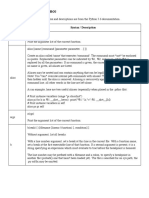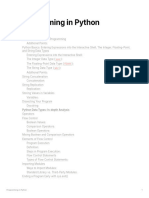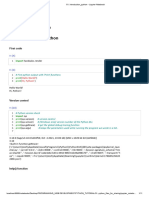0 ratings0% found this document useful (0 votes)
261 viewsPython Debugger Cheatsheet
This Python debugger cheatsheet provides commands for getting started with the Python debugger (pdb), examining and moving around code, setting breakpoints, and manipulating the debugger. The cheatsheet lists common pdb commands like set_trace() to start the debugger from a script, print and where to examine the program state, next and step to move line-by-line, break to set breakpoints, and ! to treat a statement as Python code.
Uploaded by
v2k2apjCopyright
© © All Rights Reserved
We take content rights seriously. If you suspect this is your content, claim it here.
Available Formats
Download as PDF, TXT or read online on Scribd
0 ratings0% found this document useful (0 votes)
261 viewsPython Debugger Cheatsheet
This Python debugger cheatsheet provides commands for getting started with the Python debugger (pdb), examining and moving around code, setting breakpoints, and manipulating the debugger. The cheatsheet lists common pdb commands like set_trace() to start the debugger from a script, print and where to examine the program state, next and step to move line-by-line, break to set breakpoints, and ! to treat a statement as Python code.
Uploaded by
v2k2apjCopyright
© © All Rights Reserved
We take content rights seriously. If you suspect this is your content, claim it here.
Available Formats
Download as PDF, TXT or read online on Scribd
You are on page 1/ 1
Python Debugger Cheatsheet
Getting started Movement
start pdb from within a script: <ENTER> repeat the last command
import pdb;pdb.set_trace()
n(ext) execute the current statement (step over)
start pdb from the commandline:
python -m pdb <file.py> s(tep) execute and step into function
r(eturn) continue execution until the current function returns
Basics
c(ontinue) continue execution until a breakpoint is encountered
h(elp) print available commands u(p) move one level up in the stack trace
h(elp) command print help about command
d(own) move one level down in the stack trace
q(quit) quit debugger
Breakpoints
Examine
b(reak) show all breakpoints
p(rint) expr print the value of expr
b(reak) lineno set a breakpoint at lineno
pp expr pretty-print the value of expr
w(here) print current position (including stack trace) b(reak) func set a breakpoint at the first line of a func
l(ist) list 11 lines of code around the current line
l(ist) first, last list from first to last line number Manipulation
a(rgs) print the args of the current function !stmt treat stmt as a Python statement instead of a pdb command
by Florian Preinstorfer (nblock@archlinux.us) — version 1.0 — license cc-by-nc-sa 3.0
see https://github.com/nblock/pdb-cheatsheet for more information.
You might also like
- Python Debugger Cheatsheet: Getting Started MovementNo ratings yetPython Debugger Cheatsheet: Getting Started Movement1 page
- Debugging in Python - A Cakewalk With PDB - by Rachit Tayal - Python Features - MediumNo ratings yetDebugging in Python - A Cakewalk With PDB - by Rachit Tayal - Python Features - Medium6 pages
- Aim: Perform Debugging Using Bug Tracking Tool Like PDP in PythonNo ratings yetAim: Perform Debugging Using Bug Tracking Tool Like PDP in Python2 pages
- Debugging C API Extensions and CPython Internals With GDBNo ratings yetDebugging C API Extensions and CPython Internals With GDB9 pages
- Index Modules Next Previous Python Documentation The Python TutorialNo ratings yetIndex Modules Next Previous Python Documentation The Python Tutorial4 pages
- Fristle - Closed Source Debugging With GDBNo ratings yetFristle - Closed Source Debugging With GDB3 pages
- JCA Python - Middle v. 2021 Lesson 01 FoxitNo ratings yetJCA Python - Middle v. 2021 Lesson 01 Foxit18 pages
- Python Fundamentals: Shipping Working and Maintainable CodeNo ratings yetPython Fundamentals: Shipping Working and Maintainable Code53 pages
- UNIX Shell Programming Interview Questions You'll Most Likely Be AskedFrom EverandUNIX Shell Programming Interview Questions You'll Most Likely Be AskedNo ratings yet
- Learn Python through Nursery Rhymes and Fairy Tales: Classic Stories Translated into Python Programs (Coding for Kids and Beginners)From EverandLearn Python through Nursery Rhymes and Fairy Tales: Classic Stories Translated into Python Programs (Coding for Kids and Beginners)5/5 (1)
- CSC411 Tutorial #3 Cross-Validation and Decision Trees: February 3, 2016 Boris Ivanovic Csc411ta@cs - Toronto.eduNo ratings yetCSC411 Tutorial #3 Cross-Validation and Decision Trees: February 3, 2016 Boris Ivanovic Csc411ta@cs - Toronto.edu24 pages
- ID Evdescription Parenth1 Year Period Level Prior Current TimeidNo ratings yetID Evdescription Parenth1 Year Period Level Prior Current Timeid44 pages
- ID Evdescription Parenth1 Year Period Level Prior Current TimeidNo ratings yetID Evdescription Parenth1 Year Period Level Prior Current Timeid44 pages






























































